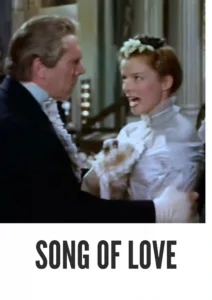Contact: info@alwanfilm.com
Video Sources 0 Views

Synopsis
Song of Love 1947 Colorized Review: A Classic Romance That Harmonizes with History

Introduction
In the pantheon of classic cinema, Song of Love (1947) stands out as a film that beautifully marries romance with historical depth. Directed by Clarence Brown, this film is a fictionalized retelling of the life of composer Robert Schumann, his wife, pianist Clara Wieck Schumann, and their friend, composer Johannes Brahms. It showcases the complex dynamics of their relationships against the backdrop of 19th-century European classical music. Starring Katharine Hepburn, Paul Henreid, and Robert Walker, Song of Love offers a unique window into the personal lives of these legendary artists. In this review, we’ll examine the significance of this film as a reflection of historical biography, explore how its early colorization enhances the viewer’s experience, and assess the impact and legacy of Song of Love within film history.
Check The Full Colorized Movies List
Check Our Colorized Movies Trailer Channel
Understanding Song of Love 1947 Colorized: Director, Cast, and Genre
Director’s Vision for Song of Love
Directed by Clarence Brown, a master of capturing human emotion, Song of Love (1947) epitomizes the director’s vision for melding the intensity of classical music with the nuanced expressions of romance. Brown was known for creating character-driven films that focused on personal struggles and relationships, and his approach in Song of Love is no different. He uses music not only as a soundtrack but as a force that shapes the lives of the characters, blending it seamlessly into the film’s structure. Brown’s direction allows the characters’ emotions to resonate through their music, adding depth to their on-screen relationships and illustrating the connection between art and love.
The Iconic Performances
The film’s cast brings both gravitas and sensitivity to their portrayals. Katharine Hepburn shines as Clara Wieck Schumann, the devoted wife and gifted pianist who finds herself torn between love and career. Hepburn’s performance is a highlight of the film, capturing Clara’s strength, intelligence, and quiet resilience. Her portrayal is both fierce and vulnerable, and it anchors the film’s emotional core.
Paul Henreid, as Robert Schumann, embodies the character’s brilliance as well as his tragic descent into mental illness. Henreid’s performance is subtle and intense, perfectly capturing the complexity of a man who struggles with both genius and personal demons. Robert Walker’s portrayal of the young, passionate Johannes Brahms adds another layer to the narrative, as he finds himself increasingly drawn to Clara despite his respect for Schumann.
Exploring the Genre
Song of Love (1947) is a fascinating blend of biographical drama, romance, and musical film. The film takes liberties with historical accuracy to create a compelling love story that is set against the backdrop of classical music. As a biographical film, it falls into the category of “musical biopic,” a genre that was popular in the 1940s and appealed to audiences fascinated by the personal lives of famous composers and musicians. Unlike typical romantic dramas of the era, Song of Love interweaves real historical figures and events with a narrative that explores love, loyalty, and sacrifice, making it an enduring classic.
Exploring the World of Song of Love 1947 Colorized: Plot and Characters
Detailed Synopsis
Song of Love (1947) follows the intertwined lives of Clara Wieck Schumann, Robert Schumann, and Johannes Brahms. The film begins with Clara (Hepburn) as a rising star pianist, married to the talented yet troubled composer Robert Schumann (Henreid). Their life is marked by both love and challenge, as Robert’s mental health deteriorates over time, casting a shadow over their marriage and his musical career.
Enter Johannes Brahms (Walker), a young, passionate composer who becomes a close friend to the Schumanns. He is both an admirer of Robert’s work and drawn to Clara’s warmth and kindness. As Robert’s health declines, Brahms’ feelings for Clara deepen, creating an emotional tension between the characters that is both poignant and understated.
Throughout the film, Clara is portrayed as a strong woman who must balance her loyalty to Robert with her growing affection for Brahms. The plot delves into the sacrifices Clara makes, both as a wife and an artist, highlighting the challenges faced by women in the arts during that era. Song of Love brings these historical figures to life through a blend of romance, music, and drama, capturing the emotional complexity of their relationships.
Complex Characters and Relationships
The film’s characters are richly developed, with each one displaying a unique set of traits that makes them memorable. Clara is portrayed as a devoted wife and a talented pianist, balancing her love for Robert with her own ambitions. Robert’s character reflects the struggles of a creative genius plagued by mental illness, and Brahms brings youthful idealism and a touch of romantic tension. These relationships are enhanced by the actors’ powerful performances, which bring depth to the film’s exploration of love, loyalty, and sacrifice.
The Art of Film Colorization
Understanding the Process
Film colorization, the process of adding color to black-and-white films, was still in its experimental stages when Song of Love was released in 1947. Originally presented in black and white, Song of Love was later colorized to bring out the visual beauty of its costumes, set designs, and the aesthetic of 19th-century Europe. The colorization process typically involves either manual or digital techniques to add hues that fit the time period and mood of the film. In the case of Song of Love, the colorization was intended to enhance the film’s romantic ambiance and historical setting, allowing audiences to see the past in a more vibrant and engaging way.
Development Over Time
The evolution of colorization techniques has significantly changed how classic films are presented to new generations. Early colorization methods were labor-intensive and prone to inaccuracies, but modern digital technology has made it possible to achieve more realistic and visually appealing results. While some purists argue that colorization alters a film’s original look, others see it as a way to bring classic cinema to contemporary viewers.
Early Colored Films: A Brief History
Emergence of Early Techniques
The journey toward full-color cinema began with techniques like tinting and toning, which were used to add splashes of color to black-and-white films. As technology advanced, filmmakers experimented with more sophisticated processes, such as Technicolor, which revolutionized the film industry in the 1930s. Technicolor used a multi-strip process to create vibrant, realistic colors, bringing films to life in ways that were previously unimaginable.
Song of Love, though originally filmed in black and white, was eventually colorized as part of the industry’s growing interest in enhancing classic films for new audiences. This movement toward colorized cinema has allowed modern viewers to experience older films in a format that feels more immersive and visually dynamic.
Song of Love 1947 and Its Colorized Version
The Decision to Release in Color
The decision to colorize Song of Love was made to bring the beauty of 19th-century Europe and its classical music culture to life. By adding color, the filmmakers sought to enhance the film’s visual impact, highlighting the historical costumes, scenic landscapes, and intimate moments between characters. This colorized version aims to evoke a sense of nostalgia and give the audience a fresh perspective on the film’s historical setting.
Impact on the Visual Narrative
The colorization of Song of Love allows viewers to appreciate the film’s visual details in a new light, adding depth to scenes that were originally presented in black and white. The costumes, settings, and landscapes come alive in color, making the world of 19th-century music more tangible and relatable. However, this change also raises questions about how colorization may alter the film’s original tone. For some viewers, the black-and-white format holds a timeless quality that color may disrupt, while others find that color adds to the film’s emotional resonance.
The Debate Over Film Colorization
Controversy Surrounding Colorization
The colorization of classic films has been a contentious topic within the film industry. Critics argue that colorization can compromise the integrity of the original film, altering the director’s intended aesthetic. They claim that black-and-white films have a unique quality that should be preserved, as the filmmakers created them with specific lighting, contrast, and shadows in mind.
On the other hand, proponents of colorization believe that it can revitalize classic films, making them more accessible and visually engaging for contemporary audiences. By enhancing the visual appeal, colorized versions can attract viewers who might not otherwise watch black-and-white films, keeping these classics relevant in an evolving media landscape.
Examining Song of Love 1947 as an Early Colored Film
Enhancement or Distraction?
The colorized version of Song of Love (1947) brings a new dimension to the film, offering audiences a fresh perspective on its visuals. Some viewers may find that the added colors enhance the film’s romantic and historical elements, making the characters and settings feel more vivid. For others, the colorization may detract from the original film’s timeless quality, potentially affecting the mood and tone that were achieved in black and white. Ultimately, the impact of colorization on Song of Love is subjective, with individual preferences playing a significant role in the viewing experience.
Influence and Legacy: Song of Love 1947 Colorized’s Impact on Cinema
The Musical Biopic Genre
Song of Love (1947) has influenced the musical biopic genre, paving the way for films that explore the lives of famous composers and musicians. Its portrayal of historical figures and its blend of romance and music set a precedent for future films in the genre. The film’s success demonstrated the appeal of stories that delve into the personal lives of iconic artists, inspiring subsequent biopics about composers like Beethoven, Chopin, and Mozart.
Director’s Cinematic Legacy: Beyond Song of Love 1947 Colorized
Clarence Brown’s Influence on Film
Clarence Brown’s directorial work extends beyond Song of Love, encompassing a range of films that explore human relationships and personal struggles. His ability to bring emotional depth to his characters has left a lasting mark on cinema. Song of Love remains one of his most celebrated works, showcasing his skill at combining historical narrative with intimate character studies.
Themes Explored in Song of Love 1947 Colorized
Darkness, Sacrifice, and Artistic Integrity
Song of Love delves into themes of sacrifice, loyalty, and artistic integrity. Clara’s struggle to balance her personal and professional life, as well as her devotion to Robert despite his illness, illustrates the sacrifices that often accompany love and artistry. The film also addresses the darker side of genius, exploring how mental illness and emotional turmoil can impact creativity and relationships.
Reception and Controversy Surrounding Song of Love 1947 Colorized
Initial Reviews and Audience Reactions
Upon its release, Song of Love was met with positive reviews, with critics praising the performances, particularly Hepburn’s portrayal of Clara. However, the colorized version sparked debate among film enthusiasts, some of whom felt that the addition of color altered the film’s original aesthetic. Despite these controversies, the film remains popular among fans of classic cinema and continues to be celebrated for its portrayal of love, sacrifice, and the power of music.
Where to Watch Song of Love 1947 Colorized Online
For viewers interested in watching Song of Love (1947), the film is available on several streaming platforms, including Amazon Prime Video and the Criterion Channel. DVD and Blu-ray editions, featuring both the black-and-white and colorized versions, can also be purchased online.
FAQs About Song of Love 1947 Colorized
Q: Is Song of Love (1947) historically accurate?
A: While Song of Love is based on real historical figures, it takes creative liberties with certain aspects of their lives to enhance the dramatic storyline.
Q: Who composed the music featured in the film?
A: The film includes compositions by Robert Schumann and Johannes Brahms, adding authenticity to the narrative and celebrating their musical legacies.
Q: Why was the film colorized?
A: The colorization of Song of Love was part of an effort to make the film more visually appealing to modern audiences, allowing them to experience the historical setting in a new way.
Conclusion
Song of Love (1947) remains a cherished classic, blending historical romance with the power of music. Clarence Brown’s direction and the outstanding performances by Katharine Hepburn, Paul Henreid, and Robert Walker make this film a moving portrayal of love and artistic dedication. While the colorized version adds a unique visual experience, the original black-and-white format preserves the film’s timeless quality. Whether enjoyed in color or black and white, Song of Love endures as a tribute to the complexities of love, friendship, and creativity.














